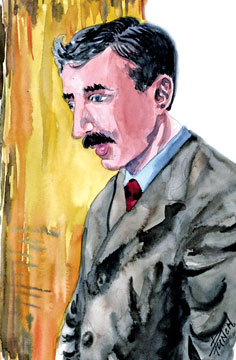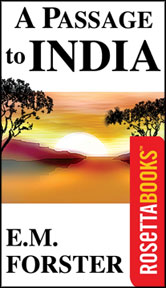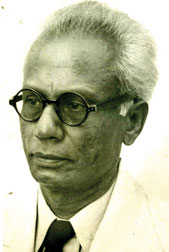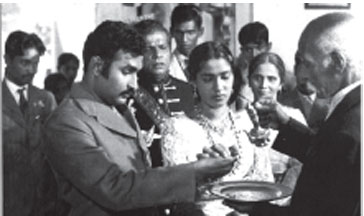Characters, themes and plots
By Shireen SENADHIRA
Several opinions came up in a discussion of the above topic of
characters and themes. One person said that it is characters and
characterization that makes the story and she added that a story could
be read slowly and enjoyably for a long time if the main character was
liked. Also, that she had once read a story, a book by Larry McMurtry,
the Pulitzer prize winner for the novel, The Lonesome Dove, and she had
liked the characters so much that she felt that she had lost good
friends when the book ended. Another opinion was that the characters
would bring out the theme themselves.
 |
|
E.M.Forster |
 Also, that the best books and movies were the ones, about people
going about their daily lives and their relationships with each other. A
third opinion was that both character and theme are highly important,
saying that if there is no good overall theme for a novel or book, it
would be all over the place, without an aim and the reader may get
confused. Characters are important to the reader and they can get to
know the characters well as the story unravels. Also, that the best books and movies were the ones, about people
going about their daily lives and their relationships with each other. A
third opinion was that both character and theme are highly important,
saying that if there is no good overall theme for a novel or book, it
would be all over the place, without an aim and the reader may get
confused. Characters are important to the reader and they can get to
know the characters well as the story unravels.
Some stories have stereotype characters who are not well developed
but these stories are focused on the plot and the sequence of events
capture the readerís attention. As they read on, they want to find out
what happens next as the plot is interesting and intricate. The stories
in which the characters are interesting, makes the reader want to know
what happens to these characters even though the plot is not original.
There are some TV series having a very popular character and the viewer
just wants to see the character and how he performs in that TV episode.
It doesnít matter to the viewer if the story is just unrealistic or
predictable.
Plot
The beauty of writing is that you can start with a plot, then,
construct your characters around the plot or vice versa. Having done
both, one must feel free to choose. Either method has come up with good
results. In writing, sometimes, one has a beginning in mind or sometimes
it is the ending, then one must work forwards or backwards to elaborate
the story. For ideas, characters can be based on your friends and plots
too can be gathered from real life. One can use dreams and even your
pets to make up plots.
Actually a story needs characters and therefore characterization is a
key role. Once the characters are established and have ties with other
characters then there will be a theme. Unless you could have a theme and
then you build your characters round it. This way would be harder,
because the theme is bound to change when other characters are brought
in.
Taking the novel written by Martin Wickremesinghe, Gamperaliya
(transformation of a village), the story portrays the erosion of
traditional village life due to the effect of modernization. The
traditional economic and social structure of the village is broken down
by the commercial culture of the city. The novel was first published in
1944 and it was praised for its realism of the depiction of the peasant
society. It was at the time the Sri Lankan society was experiencing a
social revolution. 1956 Sri Lanka elections brought in a government led
by S W R D Bandaranaike. It was a sweeping win by large mandates that
wanted to eliminate the residual elements of the colonial structure. The
many western based elite of the society then had to give way to
indigenous elite who were rooted in traditional culture and heritage.
The story of Gamperaliya unfolds that Kaisaruwatte Mudliar and his
wife Matara Hamine, represent the decaying social order. The family had
seen better days and Nanda the second daughter was being given English
tuition by a young teacher, Piyal.
Nanda is attracted to Piyal but marriage is out of the question as a
wide social gap exists between the two families. Nanda marries Jinadasa,
who has the approval of her parents. Later, as their economic plight
declines, Jinadasa leaves his home for a better livelihood but he dies
penniless. Piyal has bettered himself by that time and Piyal and Nanda
marry. Anyhow, they both have changed and the earlier idyllic nature of
their relationship eludes them.
The women in the story bring out the theme with their different
characters. The social milieu has changed each character as they fitted
themselves into the needs and thinking of the time. Matara Hamine, a
compassionate mother is practical and controlled in an emotional
upheaval as she faces reality. Anula, the unmarried elder sister was
wise, kind and strong enough to overcome her own emotions. She
understood how her mother reacted with commitment to customs and
traditions and she took it all in her stride. Nanda, a trifle frivolous
had less understanding of the societal manner. She uprooted herself,
which Anula never did, and surrounded herself with commercial comforts
of the town to live her life. Thus, the characters bring out the themes
in the story: the different status of families, the decaying social
order, the rural traditions and customs and the modern way of life in
the town and romance and cynicism. Also, old values giving way to new
ones and changes blowing in with effect in colonial times.
 |
|
Martin Wickremesinghe |
Another novel in a colonial background is E M Forsterís novel, A
Passage to India. In this novel, the barriers to inter-racial friendship
in a colonial context are explored. The novel depicts what the British
Poet, Rudyard Kipling quoted: íThe East is east and West is west and
never the twain shall meetí and this theme runs throughout Forsterís
novel. Kipling, however, was born in India and later lived in India for
a long time and this quote was written before Forsterís novel, A Passage
to India which was published in 1924.
The novel, A Passage to India explores the relations of two cultures,
the Indians and the English. The novel dramatizes the repercussions that
followed when Dr Aziz tried his best to entertain the English guests. It
is to be noted that the authorís emphasis is on the realms of the
personal and the individual rather than the social and political. It is
also a novel of colonialism and Imperialism.
It should be remembered that Forster in common with a number of his
peers in London, like Virginia Woolf, was an anti Ėimperialist. These
traits are all brought out well by the characters of the novel.
Dr Aziz, in the novel, A Passage to India, is an intelligent,
emotional Indian medical doctor who is friendly with Fielding, the
principal of a government college.
He tries to make friends with Adela Quested and Mrs Moore. Later
Adela accuses Dr Aziz of attempted to rape after an expedition to the
Marabar Caves but the charges are dropped after Adelaís testimony at the
trial. Mrs Moore, comes to India with Adela to visit her son Ronny who
is the magistrate of Chandrapore town. She hopes that Adela will marry
her son. Mrs Moore befriends Dr Aziz seeing some spiritual connection
with him but the visit to the Marabar Caves end in a catastrophe.
The Chandrapore governorís wife, Mrs Turton embodies the stereotype
snobby, rude and prejudiced English colonial wife. Professor Godbole, a
hindu teacher at Fieldingís college is a spiritual man and does not get
involved in anybodyís life.
At the time of Dr Azizís arrest when Professor Godbole is asked why
he did not seem concerned about Dr Aziz, whom he knew well, Godbole
answers that the verdict is already drawn and therefore there is nothing
he could do.
After Adelaís testimony at the trial and Dr Aziz goes free, Mrs
Turton berates Adela and as the rest of the English community except
Fielding is in accordance with Mrs Turton, Adela is left to face a
difficult time with the English community. All the above characters are
well set in the novel and they react and interact with each other
according to each temperament in a colonial time very realistically. In
this particular novel, with the mysticism of India seen in the mystery
of the Marabar Caves, the themes of the novel are woven with the actions
of characters and displayed well.
 |
|
A scene from
Gamperaliya |
A creative story needs imagination. A real happening could stimulate
the imagination for the basis of a literary story. Imagination allows
growth of characterization, motivation, setting and provides a special
memorable experience for the reader. Literary fiction explores the
imagination for the right elements to describe an event in sequential
scenes. Then, the story gets structured and the thematic goal will
influence the character and plot development.
The characters of a literary story must be interesting, be complex
and developed and contribute to the story fully. The motivations and
actions of all characters should contribute to the plot momentum. In a
good story the reader has a thorough knowledge of who the characters are
and why they do what they do. The reader follows the progressive unity
and the focus of the story. The development of the characters is always
consistent with the story conflict Ėresolution. The story resolution
should be in accord with all what the characters have done in the story.
That is the essence of storytelling. A literary story should have the
most effective characterization and plot motives to assure story
momentum and to achieve reader delight.
The truly great stories have elements of all the following:
characterization, plot and theme and the more each is developed and can
hold the readerís attention, the better it is.
However, a story, especially a short story can depend on one of these
elements and be good but it needs to have at least one very strong
element otherwise the story will amount to nothing.
|

